The autumn period is harvesting, pruning, preparing plants for winter, restoring order on the site. Usually at this time they do not plan to plant new crops, but experienced summer residents know that some varieties of shrubs, flowers, vegetables, greens, planted for the winter, become more hardy and yield in early spring. A stronger root system and resistance to frost reduce the risk of diseases, susceptibility to pests, increase productivity. To benefit from the autumn planting, it is better to know in advance - what is better to plant in this period.
Content
What are the advantages of autumn planting
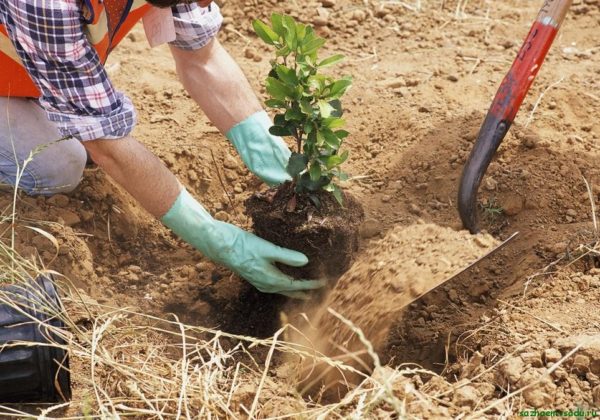 Some believe that in the autumn you do not need to plant anything in the garden, because the risk is great that the seeds will die. But it must be borne in mind that many varieties tolerate winter well, so when choosing, it is better to focus on just such. Plants that calmly winter will become stronger and give a good early crop. Natural selection will take place, during which the strongest shoots that are most resistant to frost and disease will survive and germinate. The main advantages of autumn planting include:
Some believe that in the autumn you do not need to plant anything in the garden, because the risk is great that the seeds will die. But it must be borne in mind that many varieties tolerate winter well, so when choosing, it is better to focus on just such. Plants that calmly winter will become stronger and give a good early crop. Natural selection will take place, during which the strongest shoots that are most resistant to frost and disease will survive and germinate. The main advantages of autumn planting include:
- saving time in spring for soil preparation, greenhouses, top dressing;
- early harvest;
- You can use seeds whose shelf life is nearing the end;
- in autumn, the soil is well moistened and does not require additional watering after planting;
- “Winter” crops are not so frightened by spring frosts, which can be destroyed only by seeds planted in spring;
- a strong root system is formed, thanks to which in the spring the plant will receive more moisture and trace elements from the soil.
True, it is worth considering that in addition to the advantages, there are risks:
- if you plant a plant early in the autumn in the country, it will sprout and die during frosts;
- not all cultures will survive the winter, you need to choose only those that are able to "winter";
- only light soil is suitable;
- the site should not be inclined, in a depression or near water bodies, so that the spring thaw does not destroy the seeds;
- in early spring and frost after germination, shoots are at risk.
What to plant in the country in the fall
Most often, onions and garlic are planted in summer cottages in the autumn to get an early harvest next year and please yourself with greens early. And garlic planted between rows of strawberries will scare away pests with its aroma. You can also plant dill, parsley, physalis, parsnip, carrots, beets, turnips, and leaf salads in the winter. Be sure to leave a place for flowers, shrubs, fruit trees.
Some sections will be useful seeded with green manureso that by spring the soil will be enriched with the necessary substances and trace elements.For this, winter crops are suitable - vetch, mustard, rye, oats. Depending on the type of soil and the selected plant, the soil will be equipped with nitrogen, sulfur, phosphorus. For best results, it is necessary to combine several siderates in one place at once, so that the enrichment of the soil is complex. In addition to fertilizers, for example, vetch will help in the fight against attacks of slugs, snails, pigeons, oats prevents the appearance of rot, makes clay soil more loose.
Autumn flowers for planting
Flowers in the autumn are planted both annual and perennial. More often they choose onion bulbs, also plant bushes, sow seeds. For each variety, you also need to take into account the time of planting, the type of soil, the location of the flowerbed, the main thing is to do this no later than a month before the onset of winter. Optimal dates are from early September to late October.
Bulbous must be prepared in advance - choose the strongest, dry, plant deeper, so that they do not have time to grow to frost. Some varieties are best covered for the winter. Perennial bushes are planted in September, seeds can be sown in October, small-bulbous muscari can begin in August.
Perennials
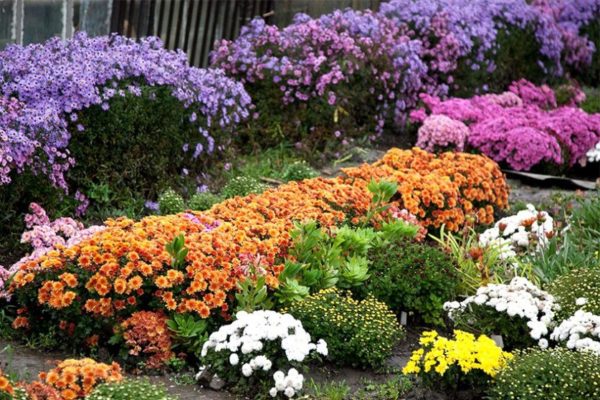 Most perennial flowers are planted, divided or transplanted in October. For them, it is necessary to prepare and fertilize the soil, because they will grow for several years in one place. Pits are best done in advance - in spring or summer. The root system must be closed, it can be rooted cuttings or cuttings from last year. Some perennial seeds do not germinate without stratification, so they will not take root if they are planted in the spring or try to plant seedlings at home. These include hellebore, delphinium, primrose. Some gardeners warn of this feature, so it is important to carefully read the packaging if you are choosing these varieties for the first time.
Most perennial flowers are planted, divided or transplanted in October. For them, it is necessary to prepare and fertilize the soil, because they will grow for several years in one place. Pits are best done in advance - in spring or summer. The root system must be closed, it can be rooted cuttings or cuttings from last year. Some perennial seeds do not germinate without stratification, so they will not take root if they are planted in the spring or try to plant seedlings at home. These include hellebore, delphinium, primrose. Some gardeners warn of this feature, so it is important to carefully read the packaging if you are choosing these varieties for the first time.
Phlox
It takes root well in sunny areas, in partial shade. Transplanted with a lump of land. The shoot must have at least two stems; after separation, the shoots are cut so that they do not exceed 20 cm.
Rudbeckia
An unpretentious plant, the main thing is to water it regularly. Tall stems grow, which eventually tied to a support. It is better to choose fertile soil in the sun or in partial shade. If the soil is clay, add sand and compost.
Primrose
Propagated by seeds or rhizomes in an open nutrient and loose soil. He loves shade and partial shade under trees and shrubs, where there is no direct sunlight.
Heicher
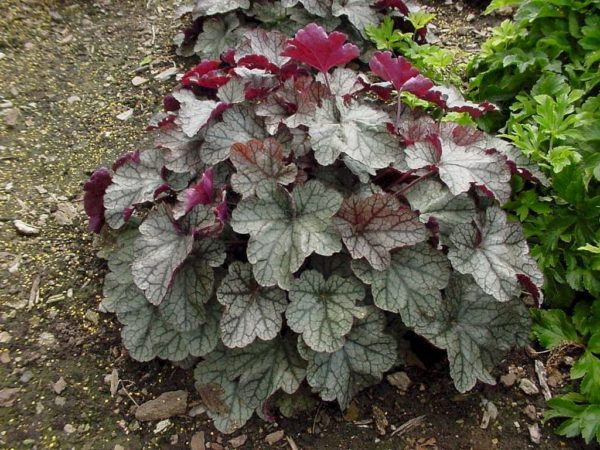 The best place for planting is the western or eastern side of the site in the partial shade of other plants. On the sunny side requires regular watering. In loose fertile soil blooms most abundantly.
The best place for planting is the western or eastern side of the site in the partial shade of other plants. On the sunny side requires regular watering. In loose fertile soil blooms most abundantly.
Lavender
It feels very good in the sun, if it grows elsewhere, then growth slows noticeably. Propagated by seeds in open ground, poorly tolerates excess moisture.
Lily
Bulbs are planted in September in a well-lit place, the main thing is that before dinner it should not be in the shade. Direct rays of the sun are undesirable, otherwise the leaves and stems burn out. Humidification is moderate, stagnation of moisture can destroy the plant.
Gentian
For her, sunny areas with a small partial shade are suitable. He loves well-drained loamy soil, which before planting needs to be fertilized with rotted leaves, sand, wood ash. Thanks to the bright blue flowers, it looks great in rockeries and flower beds among stones.
Annuals
 The timing of planting annual flowers depends on the region, the warmer the autumn, the later it needs to be done. In the southern regions, this is mid-November and even early December. In the middle lane - the end of October, beginning of November, the main thing is that the temperature does not rise above zero. At a stable plus temperature, the seeds will begin to germinate and may die if frozen. With winter sowing, flowering begins later than that of grown seedlings (about 2-3 weeks), but earlier than those that are sown in open ground in spring.
The timing of planting annual flowers depends on the region, the warmer the autumn, the later it needs to be done. In the southern regions, this is mid-November and even early December. In the middle lane - the end of October, beginning of November, the main thing is that the temperature does not rise above zero. At a stable plus temperature, the seeds will begin to germinate and may die if frozen. With winter sowing, flowering begins later than that of grown seedlings (about 2-3 weeks), but earlier than those that are sown in open ground in spring.
Annuals for winter plant in:
- flower beds (suitable for rod root systems that do not tolerate transplantation);
- school (with further shelter under the greenhouse);
- tanks (for those cases when the soil is not suitable or close to the groundwater).
Lavater
The soil can be any, the main thing is that it is loose, light. It tolerates drought, but can die from stagnation of moisture.
Iberis
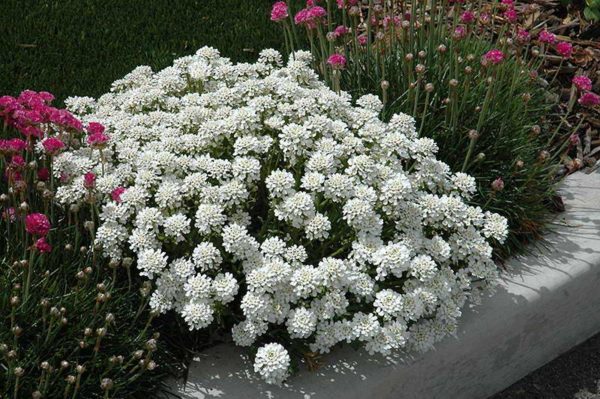 It grows on rocky, sandy soils in open sunny areas. It tolerates dampness. Very unpretentious, easily dispensed with fertilizers.
It grows on rocky, sandy soils in open sunny areas. It tolerates dampness. Very unpretentious, easily dispensed with fertilizers.
Alissum
It develops well and blooms in open places on any soil. Develops powerful branched stems creeping on the ground. Wetlands with moisture stagnation are fatal to him.
Eschscholzia
Dry sandy land and a sunny place are ideal for her. Watering is necessary only with prolonged drought. After autumn planting, it is necessary to mulch dry foliage.
Delphinium
Also loves the sun, but allows partial shade. The shoots grow tall, so it is better to choose a place under the tree, against the wall, near the fence, so that a strong wind does not damage the stem.
Cosmea
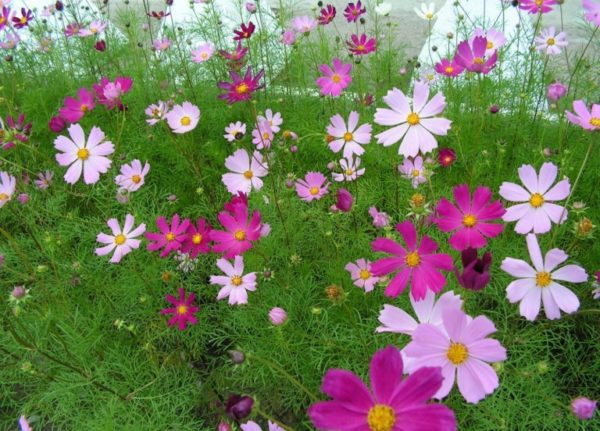 It can be planted after freezing the earth. It dispenses with top dressing, is resistant to drought, takes root in any soil. Frequent watering impedes development, slowing growth.
It can be planted after freezing the earth. It dispenses with top dressing, is resistant to drought, takes root in any soil. Frequent watering impedes development, slowing growth.
Godetia
He loves loam, which requires digging before planting and loosening in the spring, then the seedlings will sprout quickly.
Trees for planting in the fall
First of all, you can plant trees in October with a developed root system, so that they become stronger in winter. They do not require abundant watering, because they can take moisture from the lower layers of the soil. These include pear and apple tree. Also, they will calmly transfer the landing in the winter - plum, cherry plum, apricot, sweet cherry, peach.
It is very important to prepare the soil well, because fertilizers are laid immediately for a period of 7 years, in which the tree needs nutrition and development. If there is insufficient fertilizer, the seedling will die or grow for a long time without fruitingIn addition to fruit, it is recommended to plant conifers in the fall - fir, pine, juniper, spruce. Thuja and Canadian Tsuga also take root well. These trees winter well and are acclimatized.
So that the seedling does not die in the winter and is not attacked by rodents, pegs are set around, covering them with burlap, falling asleep inside leaves, sawdust. After snowfall, the top layer around the tree is rammed to protect it from frost and provide spring with moisture for development.
Fruit and ornamental shrubs
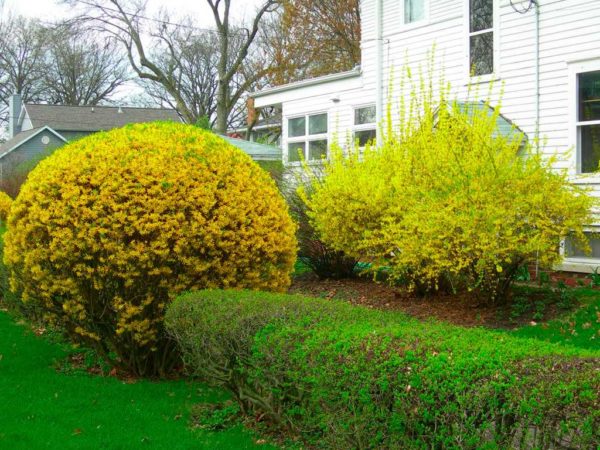 In autumn, both fruit and ornamental shrubs take root, the main thing is to choose those crops that can tolerate frosts. Earlier than others, hawthorn and red currants should be planted - the first has a developed root system, and the second requires sunlight.For bushes, you need to carefully choose a place and fertilize the soil, then they will delight with beautiful foliage and delicious fruits.
In autumn, both fruit and ornamental shrubs take root, the main thing is to choose those crops that can tolerate frosts. Earlier than others, hawthorn and red currants should be planted - the first has a developed root system, and the second requires sunlight.For bushes, you need to carefully choose a place and fertilize the soil, then they will delight with beautiful foliage and delicious fruits.
Those who use phytomedicine plant rosehips, honeysuckle, viburnum, barberry. To decorate the site fit:
- boxwood;
- spirea;
- mock-up;
- holly;
- lilac;
- jasmine;
- snowberry;
- euonymus;
- clematis;
- bird cherry;
- juniper;
- privet.
Of the fruiting plants until mid-October, they plant - black currants, gooseberries, raspberries, blackberries.
Popular vegetables and herbs for planting in the autumn in the country
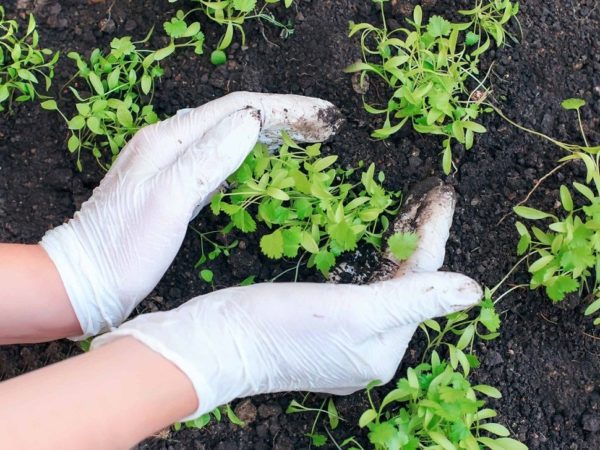 Vegetables are also sown in autumn, this is not suitable for all varieties. Most will not survive the winter, dying in the ground, but there are quite a few that will winter, spring early, and give an early harvest. Onions, garlic, parsnips, parsley, carrots, physalis, radishes - all this can be sown in September and November.
Vegetables are also sown in autumn, this is not suitable for all varieties. Most will not survive the winter, dying in the ground, but there are quite a few that will winter, spring early, and give an early harvest. Onions, garlic, parsnips, parsley, carrots, physalis, radishes - all this can be sown in September and November.
Onion
In the autumn, they plant three types of onions in the country - blackberries in seeds, turnips for greens, and seeds for the formation of bulbs. The site must be prepared - cleaned of weeds, disinfected with copper sulfate, make beds in rows. Mulch must be laid on top with a thick layer of humus or peat. Bulbs should not be deeper than 4 cm, so that they do not rot during the winter.
Onion Set
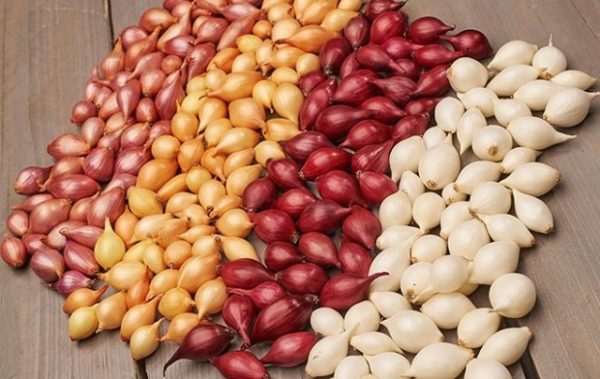 In the spring, rather weak feathers of greenery are formed in it, but by the middle of summer, the northeast grows into a large bulb. Sowing material - bulbs no more than 1 cm., Planted all fall from September to November, deepening by 3-4 cm. 5-6 cm are left in a row between them, and rows are placed at a distance of 13 cm from each other. The most popular and stable varieties are Carmen, Sturon, they are least affected by the formation of arrows.
In the spring, rather weak feathers of greenery are formed in it, but by the middle of summer, the northeast grows into a large bulb. Sowing material - bulbs no more than 1 cm., Planted all fall from September to November, deepening by 3-4 cm. 5-6 cm are left in a row between them, and rows are placed at a distance of 13 cm from each other. The most popular and stable varieties are Carmen, Sturon, they are least affected by the formation of arrows.
Turnip on greens
For juicy strong greens, which will delight in early spring, take selected onions or seeding, larger than 1 cm. Bulb diameter should be 3-4 cm. Planted to a depth of 5 cm, period - mid-October, 15 days before establishing a constant minus temperature. Watering is not required, and mulching must be done.
Black onion
Nigella are black onion seeds. In this form, onions are sown in late October, early November, even if snow falls so that they do not sprout. Seeds are laid at a distance of 2.5-3 cm. In rows, at a distance of 20 cm. They are laid at a depth of 1.5-2 cm, if the ground is frozen - sprinkle sand, humus, peat, sawdust or fallen leaves on top. The number of seeds should be greater, because it is not known how many of them will survive wintering. If the seedlings are too thick in the spring, they are thinned out.
Garlic
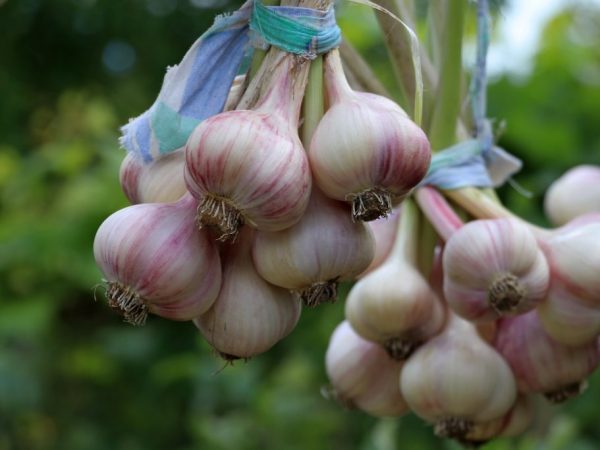 In late September, early October, they also plant winter garlic. To do this, choose larger teeth, the larger they are, the larger the heads will grow. In the holes, with the acute part up, they put healthy, without damage and signs of the disease, teeth with a removed bottom so that it does not interfere with germination. They should not be divided in advance, this is done directly on the day of planting. Between the rows leave 20 cm, inside the row between the holes there is a gap of 15-20 cm. The depth should not be more than 5-6 cm.
In late September, early October, they also plant winter garlic. To do this, choose larger teeth, the larger they are, the larger the heads will grow. In the holes, with the acute part up, they put healthy, without damage and signs of the disease, teeth with a removed bottom so that it does not interfere with germination. They should not be divided in advance, this is done directly on the day of planting. Between the rows leave 20 cm, inside the row between the holes there is a gap of 15-20 cm. The depth should not be more than 5-6 cm.
Before planting, they dig up the earth, remove lumps, stones, weeds. You should not add manure, from above you will need to mulch it with peat, sawdust, humus, which is removed with the advent of spring.
Carrot
To get an extra crop, carrots are also planted in autumn. Seeds are sown 15 days before the start of frost, when the temperature is set at a mark no higher than + 2-3 degrees. The material will need more than in the spring, by 25%, to take into account possible losses. The distance between the seeds is 2-3 cm, between the rows is 20 cm.
Beet
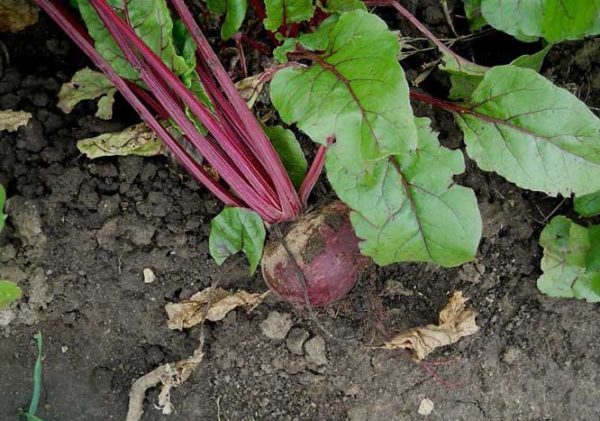 Beet not very fond of cold, because of this, not all varieties withstand wintering. Some summer residents have difficulties with choosing the optimal landing time so that it does not freeze and does not rise before the cold. Experienced gardeners recommend varieties:
Beet not very fond of cold, because of this, not all varieties withstand wintering. Some summer residents have difficulties with choosing the optimal landing time so that it does not freeze and does not rise before the cold. Experienced gardeners recommend varieties:
- "Cold-resistant-19",
- "Winter 474",
- “Incomparable”
- "Bordeaux".
The rest are subject to the formation of arrows. You can start sowing in early November, increasing the number of seeds by 15% for "safety net". Rows are divided with an interval of 20 cm, between the holes observe a distance of 10 cm. Depth - 2-3 cm., Mulch with a height of 4 cm is placed on top.
Radish
If you plant radishes in early November, then by mid-April the first crop will already ripen. With a protracted spring, it can be collected by early May. As in the case of beets, the sowing period is determined by weather conditions, when the temperature will be around 0 ° C. The rows are divided at a distance of 10 cm, between the grains they stand 3 cm. The depth of occurrence is no more than 2-3 cm, on top of the mulch is a layer of 3 cm. The varieties that are least susceptible to shooting are Dungansky, Sofit, Red Giant, Mokhovsky.
Greenery
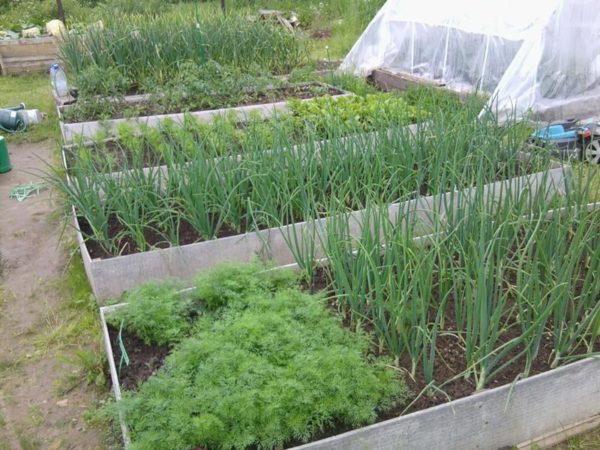 Not all summer residents use the possibility of winter planting of greenery, arguing that it quickly rises in spring. But some experienced gardeners indulge themselves with seasonings immediately after winter, laying the seeds in the ground in the fall. Sorrel, dill and parsley tolerate cold well and do not require additional care, but it is even preferable to plant a parsnip in the winter so that it passes stratification and in the spring the seedlings are stronger and more resistant to diseases.
Not all summer residents use the possibility of winter planting of greenery, arguing that it quickly rises in spring. But some experienced gardeners indulge themselves with seasonings immediately after winter, laying the seeds in the ground in the fall. Sorrel, dill and parsley tolerate cold well and do not require additional care, but it is even preferable to plant a parsnip in the winter so that it passes stratification and in the spring the seedlings are stronger and more resistant to diseases.
It is very beneficial to sow wild garlic in autumn. This healthy culture grows anywhere, without requiring special conditions - even near the fence, under the trees, in the shade. Propagated by bulbs and seeds, it is possible together with onions and garlic at the same time.
Leaf parsley
Spring parsley sprouts for a long time and grows slowly, so lovers of greenery prefer to sow it in the fall to get the first crop faster. The beds need to be dug up and fertilized, rows are placed at a distance of 15 cm, the sowing depth is 1.5 cm, between the holes 3 cm. Sprinkle on top with earth or sand. The temperature should not rise to prevent germination, so the planting process begins no earlier than the onset of stable weather 0-1ºС. Seeds will need a third more than in spring.
Some gardeners advise to pre-soak parsley seeds before planting in the ground. On their surface are essential oils that prevent germination, so they sprout for a long time. To remove the protective layer of oils, the seeds are soaked in hot water and kept in a warm place, wrapped in gauze or cloth. Sprouted seeds are placed on the lower shelf of the refrigerator, stand for 7 days, then they can be planted in the ground.
Dill
It is good to plant dill after the first weak frosts in late October. It is better to choose moist, slightly acidic or neutral loose soil rich in organic matter. High moisture levels help it grow faster. Depth - 2 cm, rows at a distance of 20 cm. Seed material will need 25% more than in spring.
Parsnip
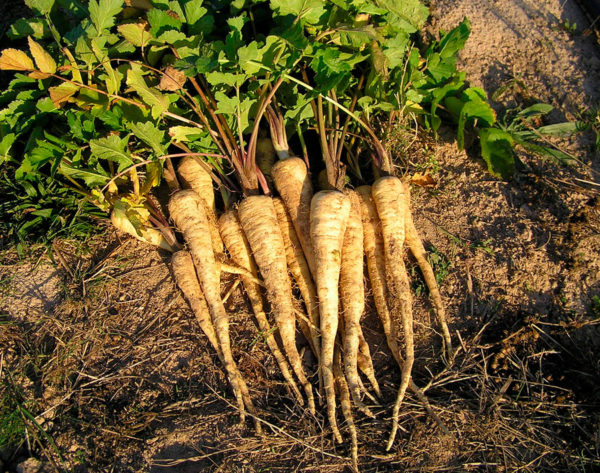 A very unpretentious plant growing on loamy, sandy loamy soils with good ventilation. For a good crop, it is better to place it in well-lit areas, otherwise the seedlings will be reduced by 40%. In preparation for sowing, the earth is dug up, phosphate-potassium fertilizers, ash, compost are introduced. In autumn, dry seeds are placed in frozen soil to a depth of 3 cm, at a distance of 10 cm. It is better to leave a longer row spacing - 35 cm. The most successful varieties are Student, Guernsi.
A very unpretentious plant growing on loamy, sandy loamy soils with good ventilation. For a good crop, it is better to place it in well-lit areas, otherwise the seedlings will be reduced by 40%. In preparation for sowing, the earth is dug up, phosphate-potassium fertilizers, ash, compost are introduced. In autumn, dry seeds are placed in frozen soil to a depth of 3 cm, at a distance of 10 cm. It is better to leave a longer row spacing - 35 cm. The most successful varieties are Student, Guernsi.
Physalis
Relative tomato, deprived of attention, physalis - a very beautiful and tasty fruit, which is also planted in October - early November. There are many varieties, both edible and purely decorative. Before winter, it is propagated by seeds, in spring from seedlings.These are quite sprawling bushes, so between them you need to maintain a distance of 50 to 70 cm, depending on the variety. Between rows - 70 cm and more, depth - 1.5 cm. Often, additional sowing is not required, since falling seeds propagate by self-sowing. The most successful vegetable varieties are Gribovsky, Krupnoplodny, Likhtarik, Strawberry, and Raisin.
Salads, leaf, cabbage and watercress
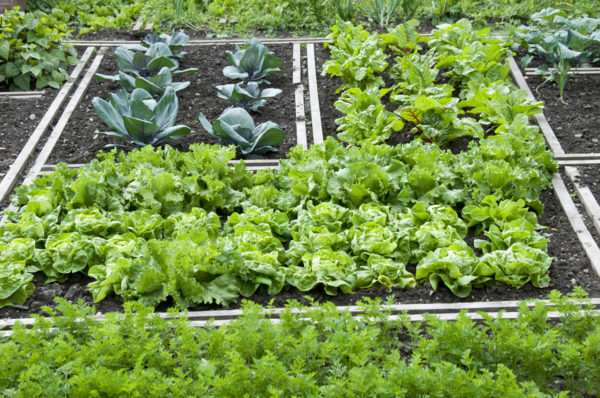 For owners of heated greenhouses, the question is not a deadline, they can grow it year-round. The rest are planted in the ground at the end of October, or later, if the autumn dragged on. The main thing is not to rush so that he does not have time to germinate. If the earth is heavy, clayey, it is lightened by adding sand. Dig the soil, fertilize with potassium salt and superphosphate, make beds. Rows are divided at a distance of 20 cm, between the seeds do not make empty places, throwing them in a continuous strip to a depth of 1-2 cm. From above, some gardeners cover them with a film so that the autumn rains do not erode the grooves. On frozen ground, seeds are scattered on top, falling asleep on top of peat, humus or dry soil. If the seedlings are thick, they are thinned out. Successful mid-season grades - "Emerald", "Berlin yellow", "Big-headed".
For owners of heated greenhouses, the question is not a deadline, they can grow it year-round. The rest are planted in the ground at the end of October, or later, if the autumn dragged on. The main thing is not to rush so that he does not have time to germinate. If the earth is heavy, clayey, it is lightened by adding sand. Dig the soil, fertilize with potassium salt and superphosphate, make beds. Rows are divided at a distance of 20 cm, between the seeds do not make empty places, throwing them in a continuous strip to a depth of 1-2 cm. From above, some gardeners cover them with a film so that the autumn rains do not erode the grooves. On frozen ground, seeds are scattered on top, falling asleep on top of peat, humus or dry soil. If the seedlings are thick, they are thinned out. Successful mid-season grades - "Emerald", "Berlin yellow", "Big-headed".
Tips for gardeners and gardeners
It is very important to choose the right landing dates and take your time. If you sow crops too early, it is likely that in the spring seedlings do not even appear. It is important that the seeds swell in moist soil, but do not have time to germinate. Most plants need to be planted in frozen ground, but it is better to prepare the beds in advance so as not to poke around in frozen ground. The end of summer, the beginning of autumn are well suited for this. On beds there should not be large lumps, the earth should be loose. Seeds are covered on top with a layer of earth or peat, which should not be frozen, so the top layer must be kept in a warm place or use purchased mixtures.
findings
Winter plantings are most beneficial in regions with stable snow cover. If he is not there or he is often blown away by the wind, you need to take care of the covering material, having prepared in advance a lapnik, film, boards, or installing wind barriers.
You can plant trees, shrubs, vegetables, greens, annuals and perennial flowers, the main thing is to choose varieties that can tolerate frosts or need stratification.
It is better to prepare the soil and beds in advance - dig, remove weeds, apply fertilizers, loosen. It is also worth remembering the mulch, so that at the time of landing it was at hand.




 10 beautiful annuals that bloom all summer
10 beautiful annuals that bloom all summer Sow in the ground, without seedlings: 10 beautiful and unpretentious flowers
Sow in the ground, without seedlings: 10 beautiful and unpretentious flowers Platicodon planting and outdoor care
Platicodon planting and outdoor care Hosta - planting and care in the open ground in the Urals
Hosta - planting and care in the open ground in the Urals